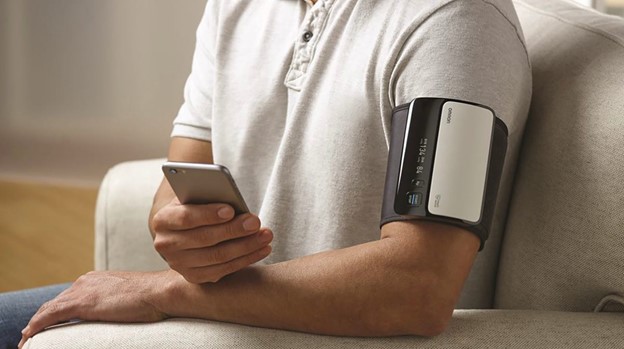RPM – Hope or Hype?
There was an obvious trend emerging at a recent cardiology conference: remote patient monitoring (RPM) devices. In one booth, a woman wore a virtual reality (VR) headset and walked down a virtual plank holding a small device while her heart rhythm and anxiety score were publicly displayed. In another, a man wore a sleek white cuff magnetically strapped to his arm and watched its blue glow as his blood pressure displayed on his iPhone. These RPM devices continuously monitor your patients' well-being and transmit the data to your office. About half of RPM devices are used to monitor cardiovascular disease and uptake is rapidly rising. Its impact will be felt to the tune of $3.7 billion per year with only 10% of Medicare patients with multiple chronic conditions enrolled (1).

The logic behind RPM is simple and compelling. RPM has the potential to increase access to care, help personalize treatment, predict decompensations, and detect subclinical disease. But it has yet to demonstrate this in a scalable and cost-effective way.
A decade of RPM for heart failure (HF) yields mixed results. Early versions involved structured telemedicine support and later included a suite of non-invasive devices monitoring weight, blood pressure, heart rate, continuous ECG and more. A 2015 Cochrane meta-analysis reported a reduction in mortality and hospitalization though the effect was small and most trials were negative (2).
Patient adherence and proper device usage were major barriers for RPM. Most platforms required patients to self-report symptoms and use home equipment such as blood pressure cuffs and scales daily. Adherence in some studies was as low as 46% after several months. According to results from the Link-HF study, even when the RPM platform consisted of only a skin-adherent ECG sensor patch, only 74% of patients completed 90 days of monitoring (3). Patients also have difficulty using their devices properly, such as measuring their weight at the same time daily. In one case, a patient reported measuring her weight while carrying her infant, triggering a HF decompensation alarm.
It can also be unclear what to do with the data collected. One might expect that a patient whose weight has consistently increased over a week of daily measurements will soon have a HF decompensation. However, it is less clear what to do with a few high readings when the baseline is sporadic or when two discrepant weights are taken in the same day. Often, a phone call is required to triage the situation, raising the question of whether device monitoring platforms add value beyond regular telemedicine follow-up. To overcome these issues, firms are developing machine learning algorithms to passively monitor RPM data and trigger decompensation alarms. Unfortunately, poor patient adherence will impede these efforts.
Although these algorithms and other technical aspects of RPM will improve, it remains unclear whether patients will welcome further intrusions of health care into their lives or if the endeavor will be cost effective. Still, investment and uptake of RPM is rising quickly. Developers can currently pursue marketing approval if they meet certain engineering and manufacturing standards, but the U.S. Food and Drug Administration places the burden on clinicians to determine the appropriate processes to use these tools effectively. The Centers for Medicare and Medicaid Services allows reimbursement for RPM devices and data interpretation with few specifications on what standards must be met for coverage, providing a financial incentive to enroll. Trials are urgently needed to determine which patients have improved outcomes with RPM and what services and devices offer the highest value.
Hope or Hype?
In 2007, Wired magazine described the "quantified self" movement: the meticulous collection and analysis of personal data for people to hack their way to better health. Prototypical adopters were young, tech-savvy men who could be coaxed to eat a diet of "Soylent Green" if their health guru claimed it improved operating efficiency. They may have more in common with physicians who fret about their patients than with patients themselves, who may be less tech-savvy, more likely to distrust the health care system, and view the routine of collecting health data the way many of us view flossing. While the impetus for RPM is compelling, its public perception would be harmed if, after painstakingly collecting patients' health data, we find that we were actually treating ourselves. With glowing blood pressure cuffs, VR demos, and a healthy Medicare reimbursement, one wonders if this may not be the case.
References
- Mecklai K, Smith N, Stern AD, Kramer DB. Remote Patient Monitoring — Overdue or Overused? N Engl J Med. 2021 Apr 15;384(15):1384–6.
- Inglis SC, Clark RA, Dierckx R, Prieto-Merino D, Cleland JGF. Structured telephone support or non-invasive telemonitoring for patients with heart failure. Cochrane Database Syst Rev. 2015 Oct 31;(10):CD007228.
- Stehlik J, Schmalfuss C, Bozkurt B, Nativi-Nicolau J, Wohlfahrt P, Wegerich S, et al. Continuous Wearable Monitoring Analytics Predict Heart Failure Hospitalization. Circ Heart Fail. 2020 Mar;13(3):e006513.
This article was authored by Steven (Shiyang) Zhang, MD, a fellow at Washington University in St. Louis.
Twitter: @notquiteSteven
This content was developed independently from the content developed for ACC.org. This content was not reviewed by the American College of Cardiology (ACC) for medical accuracy and the content is provided on an "as is" basis. Inclusion on ACC.org does not constitute a guarantee or endorsement by the ACC and ACC makes no warranty that the content is accurate, complete or error-free. The content is not a substitute for personalized medical advice and is not intended to be used as the sole basis for making individualized medical or health-related decisions. Statements or opinions expressed in this content reflect the views of the authors and do not reflect the official policy of ACC.
